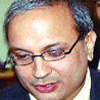What Samir Arora would have bought in India? In an interview last year Arora said that the best managed companies in India from the stock returns point of view were NDTV, Bharti and HDFC.
Samir Arora was India 's best-known fund manager. His greatest strength lied in picking up multibaggers long before the markets had spotted them. Pantaloon Retail, Trent, Bharti Telecom, P.N.B, Hero Honda, Infosys, Zee Telefilms, HDFC Bank and Satyam were a few of his outstanding stock picks. He entered into Satyam and HDFC Bank when it was not being covered by any of the research analysts. It is said that during a conversation with the head of a tech company, he suddenly walked out, told his brokers to buy 500,000 shares of the company, and then rejoined the meeting. He had the tenacity to stick with stocks for a long time. He often talks about HDFC Bank as a 20-year story.
A mechanical engineer from IIT and an MBA topper from the Indian Institute of Management- Calcutta (1986), 41-year- old Arora dropped his doctorate programme at Wharton midway, collected a Masters in Finance instead, and flung himself into the stock markets. In 1991, he joined Alliance in New York . After a two-year stint as an international analyst, he became chief investment officer of the Indian operations.
Basically a top down player Arora loved making that broad macro call and then went forward to look for the best performing company in that sector. Even if he was convinced about the standalone potential of a particular stock he resisted from investing in the sector if the sector as a whole was experiencing a tough macro environment His analysis started with the top down approach and the bottoms up research came in separately later on. While there was always a talk that Arora was too friendly with market operators and company managements we would concentrate on his investing strategies and thinking rather then become judgemental about his dealings.
- The main parameter to look at is the P/E. Investors may also look at the Profit/Profit Before Tax to neutralize the effect of taxes.
- Investors should also focus on Return on Equity(RoE) but analyzing a company on the basis of DCF is an utter waste of time. Arora contends that DCF cannot be looked at for more then one or two sectors. This is because you really have no idea about what will happen to a company beyond three years.
- Buy good businesses. In a bad business, the value that a good management can add is very low. An ordinary management in a good business often keeps its momentum. But fraudulent managements should always be avoided
- For a normal steady business you can never rely on the EV/EBITDA.
- A tax-saving company is perhaps the worst company in India because it lets taxes determine its strategy
- There are several instances where Samir Arora used his veto to get directors changed in private companies just to help them get a higher P/E.
- In many cases, money has not been made by buying the best managements but the managements that want to become the best.
- High P/E do not come because of high earnings or because that company is in a good industry. It is earned over a period of time
- If one learns how to invest in India, he can invest almost any where in the world. Investing in India teaches the analyst how to identify managements that are cheating their share holders. One also understand why two stocks in the same sector don't get the same rating.
- Arora started buying HDFC Bank after it got listed in 1995. At that time the stock traded at Rs30. It remained a dog till 1998. Suddenly it flared and went up to Rs250.It stayed there for a while and then started its course to Rs 700. Arora liked such stocks and kept buying them because as long as the company’s earnings kept growing at 30% and the stock remained stagnant it would become cheap and ripe for another rise.
- He also bought 5% of Satyam in 1995. The stock did not move much for two years. But once software was in demand Satyam did not stop.
- The most difficult thing is selling a stock when its valuations become too high. Arora advises investors to sell on company disappointments rather than on valuations.
- Churning high PE stocks for low PE stocks within the same sector is never a good decision. Post the tech bubble while Infosys and Wipro fell 60%, virtually every small stock fell 90-95%. Technology stocks like Infosys and Wipro had the highest P/E in January 2000 and had fallen the least by November 2001.


No comments:
Post a Comment